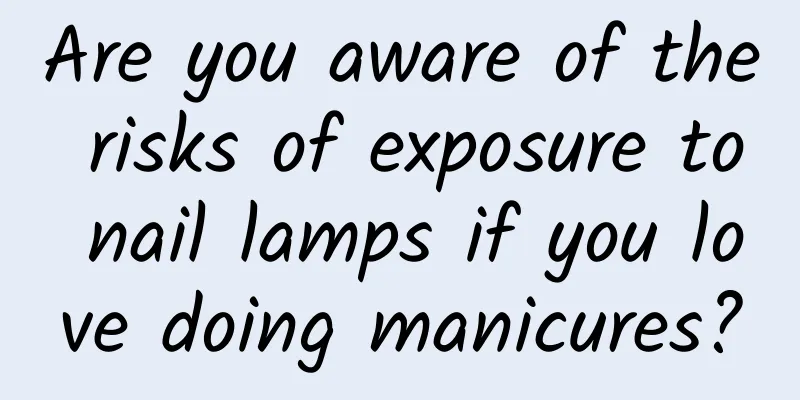Are you aware of the risks of exposure to nail lamps if you love doing manicures?

|
The Spring Festival is here, and many beauty-loving women have already arranged their "New Year armor" early. In recent years, manicures have been favored by many beauty lovers. Since nail polish dries much slower than nail polish, it needs to be cured quickly by irradiation with a nail light therapy lamp. It is understood that most consumers change their nails 4-6 times a year on average. During a manicure, the nail lamp is irradiated at least 5 times, and each exposure takes about 1 minute. Although most people do not feel uncomfortable when using the lamp, there are some safety risks if it is used improperly, so it must be taken seriously. How nail light therapy lamps work Nail phototherapy lamps are also called ultraviolet nail lamps. Common nail lamps on the market are divided into ultraviolet UV fluorescent lamps, LED lamps or UV+LED combination lamps according to their materials. These bulbs can emit ultraviolet light with a wavelength between 365nm and 405nm, which is used to activate the photoinitiator in nail polish. Ultraviolet light (UV for short) is a type of electromagnetic radiation with a wavelength range of 10nm to 400nm, which is outside the purple part of the visible spectrum and cannot be detected by the naked eye. Therefore, when the nail lamp is working, it usually lights up a purple light to show its working status. Photoinitiators can absorb these specific wavelengths of ultraviolet light energy, thereby initiating polymerization or cross-linking reactions in the oligomeric resins in the nail polish. These two chemical reactions will form new chemical bonds between the molecules in the gel or coating material, forming a high-polymer structure, which will allow the gel to quickly solidify and harden into a hard and durable state. Ultraviolet nail lamps may damage human cells UV nail polish drying devices used to cure gel manicures may pose a greater public health concern than previously thought, according to a study from the University of California, San Diego. Researchers studied these UV-emitting devices and found that their use can cause cell death and cancer-causing mutations in human cells. Such devices are common devices in nail art and typically use a specific spectrum of UV light (340-395 nanometers) to cure the chemicals used in gel manicures. Studies have shown that the UV spectrum used by tanning beds (280-400 nanometers) is carcinogenic, but the spectrum used in nail dryers has not been studied in depth before. This time, researchers used three different cell lines - adult epidermal keratinocytes, human foreskin fibroblasts and mouse embryonic fibroblasts. The results showed that using this ultraviolet emitting device for only 20 minutes once will cause 20%-30% of the exposed cells to die, while using it three times for 20 minutes in a row will cause 65%-70% of the exposed cells to die. Exposure to ultraviolet light will also cause mitochondrial and DNA damage to the remaining cells and lead to mutations, the pattern of which can be observed in human skin cancer. The results of the study show that long-term use of ultraviolet nail lamps poses a hidden danger to human cells and should be taken seriously. Safety risks of nail lamps The Shanghai Consumer Rights Protection Committee purchased several leading nail lamps through e-commerce platforms, including desktop and portable handheld models. The outer packaging of these nail lamps generally claimed that they had the product advantages of protecting eyes and preventing hands from turning black. Source: Shanghai Consumer Protection Committee However, after testing by authoritative laboratories, the results showed that these products did not meet the national electrical safety standards, and most nail lamps did not meet the national standards in multiple test indicators, posing potential safety risks. What is more worrying is that all 20 nail lamps have ultraviolet safety risks. Among the 18 samples tested, the danger level of ultraviolet rays to the skin and eyes during operation reached a high level of danger, while the other two were moderately dangerous. In addition, no relevant risk warning information was found in the instructions on the packaging of such products, resulting in many people not being aware of wearing protective equipment when doing manicures. Source: CCTV News In addition, some consumers feel burning and stinging when using nail lamps. To address this issue, testers used a human hand model to test the temperature rise of the nails and the back of the hand when the lamp was turned on. Under normal circumstances, it is safer to control the temperature rise of the fingers within 15K. The temperature rise of the nails of the samples this time was between 7.3-30.8K, and the temperature rise of the back of the hand was between 8.0-41.8K. The greater the power of the nail lamp, the higher the irradiance, the faster the heat release rate of the photocuring reaction, and the more likely it is to cause thermal damage or even burns. Yang Yue from the National Electric Light Source Quality Inspection and Testing Center of the Shanghai Quality Inspection Institute said that in this case, doing a manicure is equivalent to not taking any protective measures. Traveling to high-altitude and high-ultraviolet areas will cause problems such as blackening and pigmentation, and even cause other lesions. Therefore, it is best to take necessary protection when looking at the light. You can choose black and high-count gloves to protect the skin of your hands. Don’t let manicure become “destructive” What are the risks of frequent manicures? During the manicure process, thinning the nails may damage their protective layer, reduce resistance to irritants, and affect nail health. Frequent manicures or improper manicure operations may lead to nail diseases. Some nail salons do not have a regular disinfection process, and customers are easily infected with diseases such as tinea manuum, onychomycosis, and paronychia. Long-term use of nail polish will hinder the breathability of the nails, change the blood circulation of the nails, and over time, the finger sensitivity will be poor. Poor-quality nail polish may contain excessive heavy metals and banned additives, and long-term use may cause chronic poisoning or even cancer. Experts warn that pregnant women who use nail polish containing "phthalates" for a long time may cause fetal malformation, and should stop manicure before preparing for pregnancy. Comprehensively compiled from CCTV News, Shanghai Consumer Protection Committee, National Emergency Broadcasting, Science and Technology Daily |
>>: Are parasites reliable as drug "couriers"? | Ficus microcarpa
Recommend
Xu Kaiwen Psychoanalytic Psychotherapy Beginner-Intermediate
Introduction to Xu Kaiwen's psychoanalytic ps...
Deep dive into the four major ways to grow educational apps
Online education has been a very hot field in rec...
How to avoid the “illusion of traffic” and design a successful marketing campaign?
We know that any economic operation or business m...
China Passenger Car Association: Wholesale sales of new energy passenger vehicles by manufacturers in June 2023
New energy passenger car market forecast for June...
Interpretation of 2015 I/O Conference: A small year for Google and a big year for Android
The development of technology companies also has ...
Brand cross-border marketing: 1 plus 1 is greater than 2, how to do it?
I have seen a lot of brand cross-border cases rec...
Learn these 6 ways to play, and your Douyin account can also bring goods
As Douyin’s ability to sell goods continues to im...
Why can't you change seats on the plane? Must you board the plane through the left door? The truth is not that simple
Ding~ Welcome aboard The smiles of the flight att...
How can humans have high-quality sleep?
One third of a person's life is spent sleepin...
27 iOS open source libraries recommended to improve efficiency
I love open source, and I love the developers who...
What is the investment price of Haidong Rubber and Plastic Mini Program? Haidong Rubber and Plastic Mini Program Investment Price Inquiry
How much does it cost to attract investment for t...
In the mobile era, do you still need a domain name?
With the decline of PC, the domain name that was ...
One article is enough for the year-end marketing plan of wine promotion
How to promote alcoholic products? An article wil...
How to make your "promotional activities" a big hit?
Everyone should have had this feeling: when you a...









